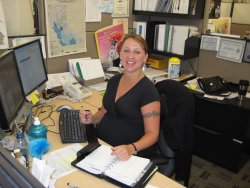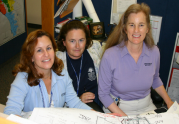Women's Success Stories

|
AMY STOREY “Take the reins and do it. Don’t underestimate yourself.” |
Career Quick Look
| Salary: | $58K - $68K | Education: |
| Years in Field: | 5 years |
SD Mesa College, GIS Certificate Program Ohio State, 2 years |
| City/State: | San Diego, CA |
Getting Started: Amy Storey found her way into GIS pretty much by accident. After attending Ohio State for two years after high school, she became a waitress to pay for college. During a series of moves around the country, she worked mainly in food service, waiting tables, tending bar, and later managing a restaurant and bar. When she moved to San Diego, she had trouble finding a food service job, and decided that office work might offer more job security. When she realized that she didn’t have enough office experience, she bought Excel for Dummies and taught herself Excel, which helped her qualify for temp work. One of her first temporary office jobs was as a receptionist at Nolte Associates, a civil engineering consulting company.
This transition was difficult financially at first, since she was earning $300 a shift in food service and started out as a receptionist at $11 per hour. After six months as a receptionist at Nolte, an engineering manager who was leaving the company to start his own business offered her a project management job. Because she enjoyed her work at Nolte, Amy decided to see what other options for advancement were available to her before accepting his offer.
Her inquiry resulted in a promotion at Nolte to a Project Assistant role. She was asked to assist a new GIS manager brought in to run a new five-year contract with the Federal Emergency Management Administration (FEMA). Amy helped to set up the GIS system at Nolte to convert the flood insurance rate maps and studies to a digital format for FEMA Region IX. The project is part of the five year Map Modernization effort that is being conducted nationwide.
Amy learned quickly and as she got to know the software used in GIS her role expanded. She observed the many possibilities available to her in GIS, and she realized that this was exactly the career she wanted. She was then promoted to a role as a Junior GIS Analyst. She received two weeks of introductory GIS courses at ESRI’s Redland campus, but most of her training during her first few years was through hands-on work she did on projects.
“This company has really been great – they’ve opened up a lot of opportunities for me,” says Amy. Her initial GIS manager at Nolte served as a role model and coach, helping her learn cartography, mapping, and a love for GIS. A later manager helped her learn management and communication skills, and sent her to the Urban and Regional Information Systems Association (URISA) leadership academy.
The manager she initially supported left Nolte about three years ago, and she has since taken over the project management responsibilities on the FEMA project which averages over a million dollars a year. In addition to managing the FEMA project, she also does planning, marketing, and business development. She was promoted once again about a year and a half ago to an Associate GIS Analyst position. Her efforts have been rewarded with an increasing income, along with a generous benefit package. Since Amy is now in the late stages of pregnancy, she has found the benefit package especially valuable.
Education: Amy attended Ohio State right out of high school for two years, but did not complete her degree. When she accidentally discovered GIS, she had no official education in the field. Once she was promoted into her first official GIS role, she attended a two-week Introduction to GIS program offered by ESRI, the software used widely in GIS. As she began to settle into the GIS field, she enrolled in SD Mesa College’s GIS certificate program. She has now completed the course work for that program. The GIS certificate program at SD Mesa was a great fit for Amy, who sometimes works 50 to 60 hours a week. She was able to take one class at a time during her off hours.
“I really enjoyed it,” says Amy of the SD Mesa GIS certificate program. She gained exposure to many new parts of GIS, learned about new tools, and delivered complex presentations with other students. “I grew my skill set, and I now have more to offer.” She especially enjoyed a project related to traffic flow in the city of San Francisco that she completed in partnership with another student who was a traffic engineer. She also has brought back what she learned in a spatial analysis course to the survey department at Nolte. Amy would like to eventually go on to complete her bachelor’s degree; although she feels fortunate to have found work in the field without educational credentials, she would like to prepare herself for future opportunities.
Amy has also taught herself multiple software packages, including PowerPoint, Access, AutoCad, and Acrobat. “I’m just very eager to keep growing and keep learning, because I feel GIS has so much to offer in so many different ways,” says Amy.
Greatest Professional Achievement: The FEMA project Amy now manages, known as the Digital Flood Insurance Rate Map (DFIRM) project, digitizes flood and levee data for 20 counties throughout the state of California. She serves as the main point of contact for contractors, FEMA, engineers, the Department of Water Resources, and the Army Corps of Engineers. “I’ve been managing the program and keeping it going since the end of 2005. I take a lot of pride in continuing to provide good deliverables, and I’ve gotten some certificates of appreciation from FEMA and have been rewarded here at work for the good feedback we’ve gotten from the client. For me, it’s a pretty major project, so being able to manage a $2 million project and keep it going and under control is the biggest accomplishment I’ve had,” she says.
Amy is also proud of a community guidebook she created two years ago for FEMA for Region 9. The guidebook brought together forms, accuracy standards, and outlines of the projects, and is still used today to inform and prepare the communities involved in the DFIRM project.
Barriers: Amy finds that her biggest barrier in the business development part of her job is that her potential clients often don’t know enough about the GIS field to know what to ask for. GIS has gotten very popular, so everyone wants to have the latest bells and whistles, and she sometimes has to spend time educating prospective clients about what will and will not be feasible in their particular situation. She has learned how to draw out the information she needs from each client so she can outline a solution that makes sense for them.
She also notes that on occasion there is still a “boys club” attitude among some clients, who would feel more comfortable or confident talking to a man. Fortunately, she has not noticed these attitudes within her own work group.
Working with Men: Amy’s current environment is a pretty even mix of men and women, even in the management ranks. She has found the men to be quite supportive; two of her male managers became mentors, supported her learning curve, and offered her training opportunities to help her build skills.
Advice for Women: Amy recommends that women try not to postpone their education. She wishes now that she had started back to school earlier, so she could have devoted more time to it before she became responsible for so many things on the job, and had such long work hours. She’s grateful that she finished her certificate and looks forward to getting her degree.
Amy recalls the time when her manager resigned and they asked her to take on his position. “I didn’t know if I could do this. I still think I underestimate myself a lot, when other people say ‘we know you can do it.’” She suggests that women who are interested in GIS and are presented with a challenge “take the reins and do it, don’t underestimate yourself.”
Typical Workday/Environment: Most of Amy’s work is done in an office environment, except when she is traveling or visiting a site. She spends 75% of her time managing the FEMA project, including the supervision of three people. She also tracks budgets and updates spreadsheets to meet FEMA requirements. She supports the work of the survey, wastewater, and water resource departments. She may also do business development, and prepare proposals and exhibits. She doesn’t have time for much production work now, but on rare occasion may digitize maps. “I have been able to prove myself, and I think a lot of people rely on me. It’s good, I like the challenge. It can be overwhelming sometimes, but it seems to work out,” says Amy, who often finds herself multi-tasking.
Amy also travels around the state to work with the communities involved in the DFIRM project. When she meets with a client or attends outside meetings, Amy wears a suit. The dress code in the office at Nolte on a normal day is business casual. She describes her work environment as very relaxed, where people work hard but also joke around and have a good time.
Career Ladder: Amy has already received three promotions in her five-year tenure with Nolte Associates, so she is optimistic about career development opportunities. Nolte employees must meet and exceed performance and accountability standards to receive raises and promotions. In her current position as Associate GIS Analyst, she could become eligible to advance to a Senior GIS Analyst position, and eventually to a GIS Manager role. Higher level opportunities include the GIS Coordinator role, coordinating work across multiple offices. She believes that the GIS group at Nolte, now incorporated into another department, will eventually become a standalone department, with more opportunities resulting.
Professional Associations: Amy is an active member of both the national and the Southern California chapter of URISA.
Hobbies: Amy loves the beach and surfing. She and her husband also enjoy camping and hiking during the summers in California and Mexico. She’s a big reader and loves to travel.
 Copyright 2010 National Institute for Women in Trades, Technology & Science | http://www.iwitts.com |


